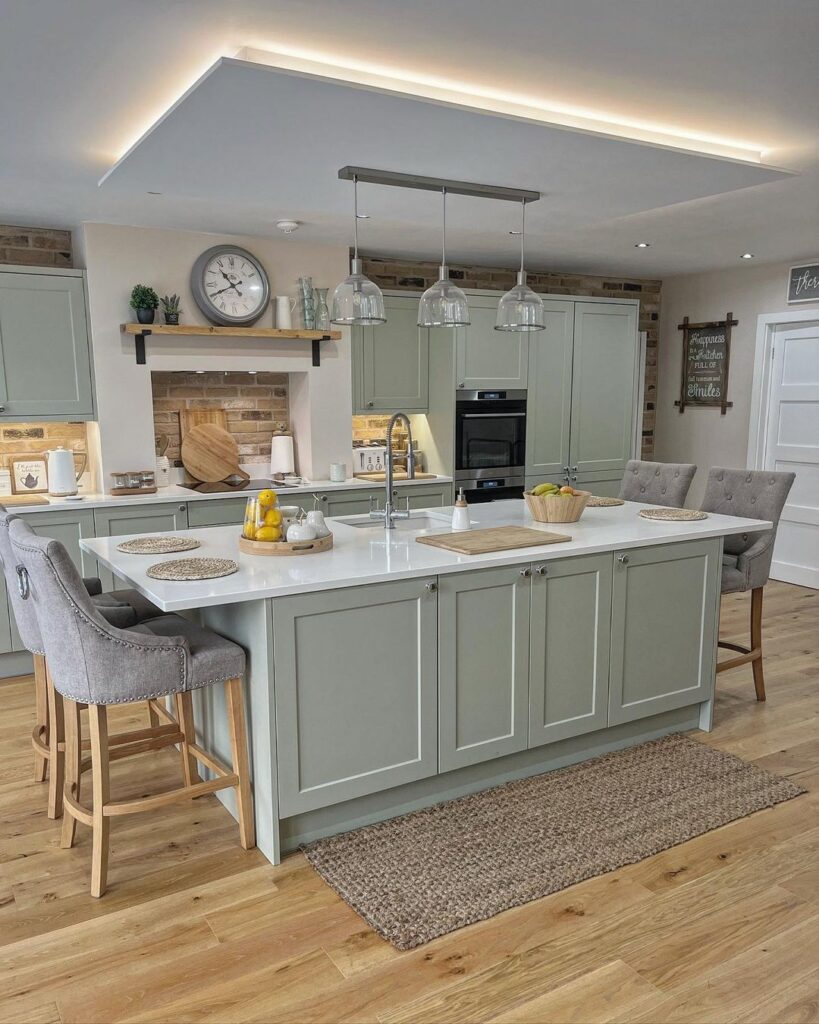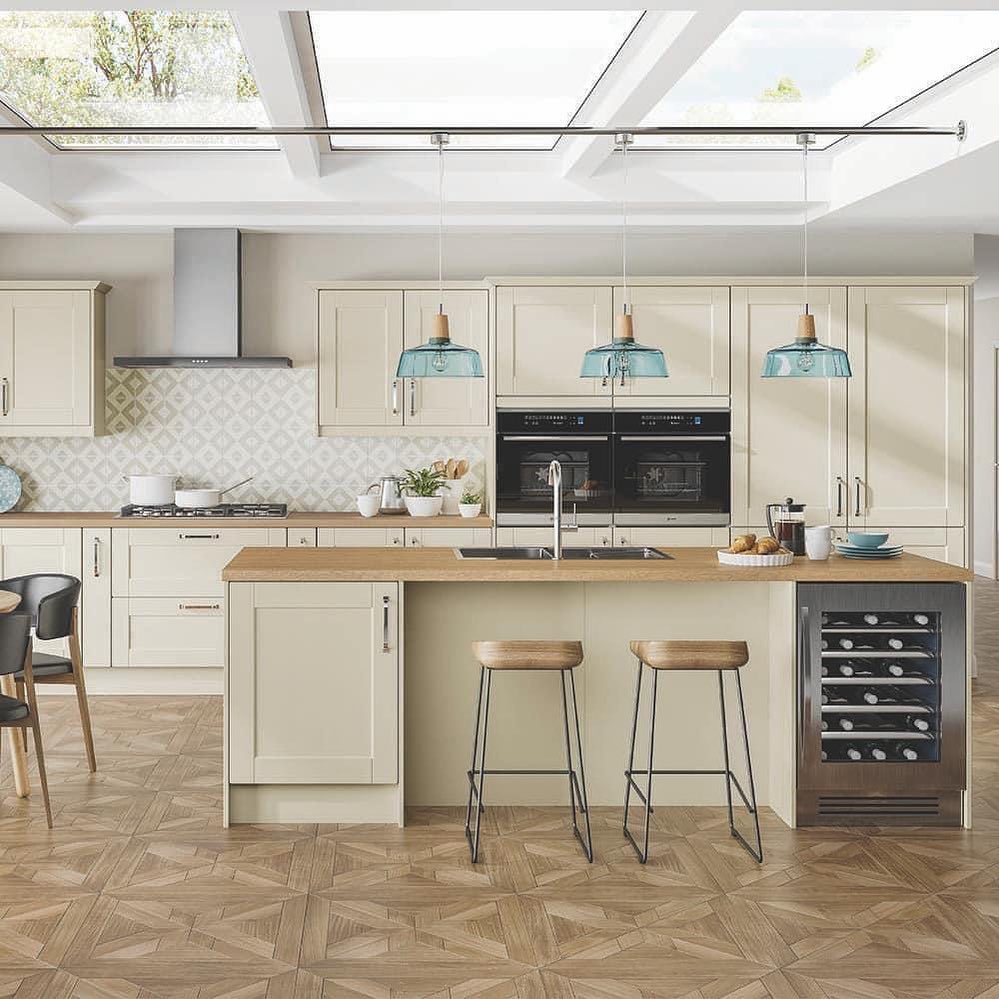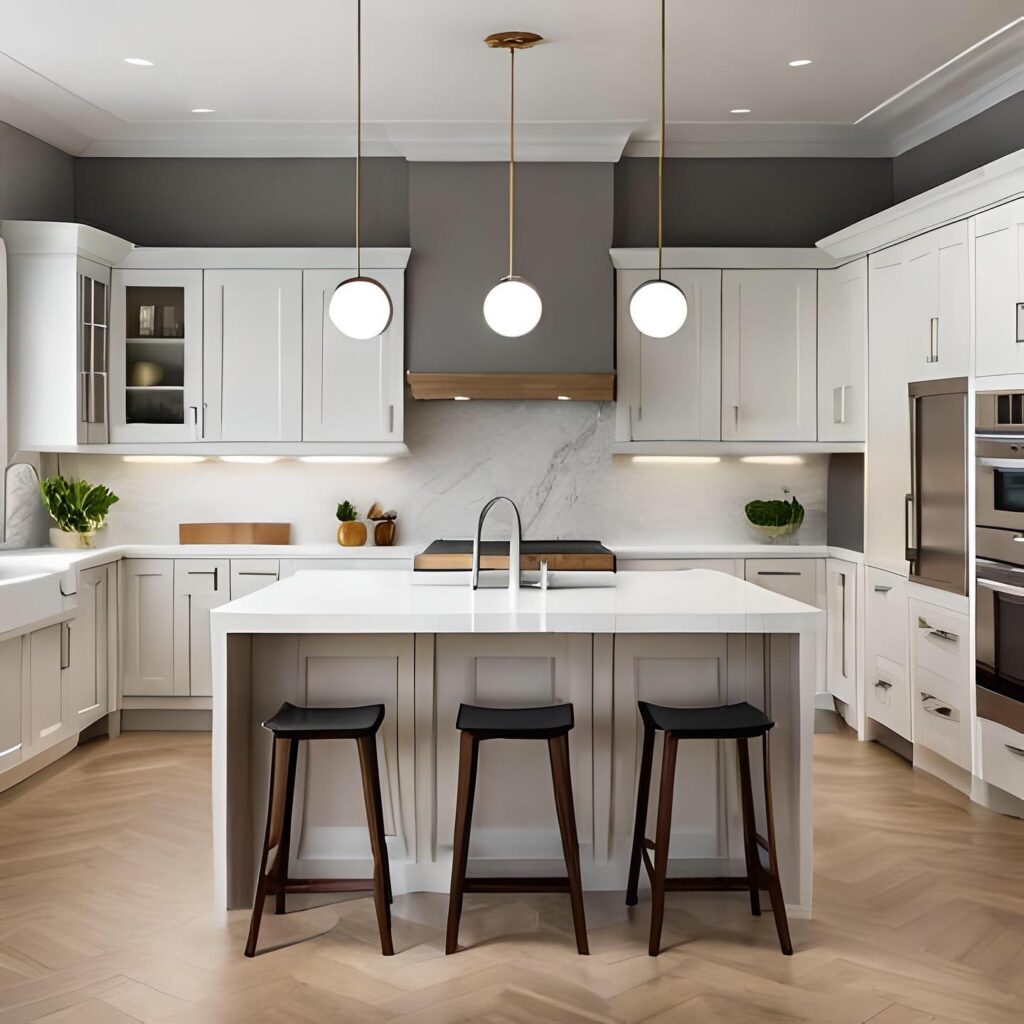
Get ready to transform your kitchen with the ultimate focal point – the kitchen island! In this comprehensive guide, we’ll explore the world of kitchen island design, covering everything from layout considerations to material choices, and from functional features to stylish finishes. Whether you’re renovating your current kitchen or starting from scratch, this article will provide you with expert insights and creative ideas to help you craft the perfect kitchen island design that suits your unique style and needs.
Introduction: The Heart of the Kitchen
Welcome to the wonderful world of kitchen island design, where functionality meets style and innovation takes center stage. The kitchen island has become the heart of modern kitchens, offering a multifunctional space for cooking, dining, socializing, and storage. With its versatility and eye-catching appeal, the kitchen island has transformed from a simple countertop extension to a design statement that elevates the overall aesthetic of your kitchen.
When it comes to kitchen island design, the possibilities are endless. From the layout and size to the materials and features, every decision you make contributes to the final result. By understanding the key considerations and exploring various design elements, you can create a kitchen island that not only enhances the functionality of your space but also reflects your personal style.
Kitchen Island Design: Creating a Functional and Stylish Space
The kitchen island is more than just an additional countertop; it serves as a hub for culinary activities, storage, and social interaction. To ensure your kitchen island design meets your needs, let’s delve into the important factors to consider during the planning phase.
Layout Considerations for Kitchen Islands
The layout of your kitchen plays a crucial role in determining the optimal design for your kitchen island. Whether you have a spacious open-concept kitchen or a cozy galley kitchen, the layout will influence the shape, size, and placement of your island.
In open-concept kitchens, where the island is often positioned as a focal point, a freestanding or L-shaped island can create a natural flow between the cooking, dining, and living areas. On the other hand, galley kitchens may benefit from a narrow, streamlined island that maximizes storage and workspace without obstructing the flow.
Choosing the Right Size for Your Kitchen Island
Determining the size of your kitchen island is crucial for achieving a harmonious balance between functionality and space utilization. While the size may vary depending on your kitchen’s layout and dimensions, there are general guidelines to consider.
As a rule of thumb, leave a minimum of 42-48 inches of space between the perimeter countertops and your kitchen island to ensure easy movement and comfortable workflows. This clearance allows for cabinet and appliance doors to open fully, preventing any potential collisions. Moreover, consider the number of people using the kitchen simultaneously. If you frequently entertain guests or have a large family, opt for a more substantial island to accommodate seating and socializing.
Determining the Ideal Height for Your Kitchen Island
The height of your kitchen island is another vital aspect to consider. The standard height for kitchen islands is 36 inches, aligning with the height of your kitchen countertops. However, if you plan to incorporate seating or a raised dining area, consider a higher bar height of around 42 inches. This elevated surface not only adds dimension to your island but also creates a visual separation between the cooking and dining areas.
When deciding on the height, take into account the comfort of users and their preferred seating options. Bar stools or chairs with a height of 24-26 inches work well for standard kitchen islands, while taller stools with heights of 30-32 inches are more suitable for bar-height islands.
Deciding on the Shape and Configuration
The shape and configuration of your kitchen island have a significant impact on both aesthetics and functionality. There are various shapes to choose from, including rectangular, square, circular, and custom designs tailored to your specific needs.
Rectangular or square islands are popular choices as they provide ample countertop space and allow for easy incorporation of appliances, sinks, and storage. Circular islands, while less common, offer a unique and elegant design that promotes social interaction and smooth traffic flow.
Furthermore, consider the configuration of your island, which refers to the arrangement of its components. U-shaped islands provide maximum storage and workspace, while L-shaped islands are ideal for open-concept kitchens. If you desire flexibility, a movable or freestanding island allows you to rearrange your kitchen layout as needed.
Selecting the Perfect Countertop Material
The choice of countertop material not only impacts the visual appeal of your kitchen island but also determines its durability and maintenance requirements. Here are some popular options to consider:
- Granite: Known for its natural beauty and durability, granite countertops are resistant to scratches and heat. Each slab is unique, adding a touch of elegance to your kitchen island design.
- Quartz: Engineered quartz offers the beauty of natural stone with enhanced durability and low maintenance. It is non-porous, making it resistant to stains and bacteria, and comes in a wide range of colors and patterns.
- Marble: With its timeless elegance and unique veining, marble adds a luxurious touch to any kitchen island. However, it requires regular sealing to protect against stains and scratches.
- Butcher Block: For a warm and inviting aesthetic, consider a butcher block countertop made of hardwood. It provides a sturdy surface for chopping and food preparation but requires regular oiling to maintain its luster.
- Stainless Steel: Popular in professional kitchens, stainless steel countertops offer a sleek and modern look. They are resistant to heat, stains, and bacteria, making them a practical choice for avid cooks.
- Concrete: A versatile and customizable option, concrete countertops can be shaped to fit your unique design preferences. They can be polished for a smooth surface or textured for a more rustic look.
Remember to choose a countertop material that complements your overall kitchen design and aligns with your lifestyle requirements. Consider factors such as durability, maintenance, and budget when making your selection.

Enhancing Functionality: Must-Have Features for Your Kitchen Island
To optimize the functionality of your kitchen island, it’s essential to incorporate specific features that cater to your cooking and entertaining needs. Let’s explore some popular additions that can take your kitchen island from ordinary to extraordinary.
Integrating a Sink into Your Kitchen Island
Adding a sink to your kitchen island can significantly enhance its functionality, allowing for efficient meal preparation and cleanup. When considering this option, ensure you have proper plumbing connections and sufficient countertop space around the sink for food preparation.
A sink in the kitchen island promotes a seamless workflow, enabling you to wash, peel, and chop ingredients without having to move back and forth between different workstations. Additionally, it serves as a convenient cleanup station, especially when you’re hosting gatherings or have multiple cooks in the kitchen.
Incorporating Appliances and Cooktops
If you’re an avid cook or enjoy hosting dinner parties, incorporating appliances and cooktops into your kitchen island design can be a game-changer. It brings convenience and efficiency to your culinary endeavors, allowing you to prepare meals while engaging with your guests.
Consider installing a cooktop on your kitchen island, complete with a ventilation hood or downdraft system to eliminate cooking odors and grease. This setup creates a dedicated cooking zone, separate from the main kitchen area, and ensures that the chef remains at the center of the action.
Furthermore, you may choose to integrate other appliances into your island, such as a wine cooler, beverage refrigerator, or microwave. These additions add functionality and accessibility to your kitchen, making it a versatile space for all your culinary needs.
Adding Storage Solutions
One of the primary advantages of a kitchen island is the additional storage it provides. Maximizing storage space ensures that your island serves as a practical and organized hub for your kitchen.
Consider incorporating various storage options such as drawers, cabinets, and open shelves into your island design. This allows you to store frequently used utensils, cookware, and pantry items within easy reach. Customizable inserts and dividers are great additions to keep your drawers organized and ensure everything has its designated place.
Additionally, consider including specialized storage solutions, such as built-in spice racks, knife blocks, or pull-out trash bins. These clever features contribute to a clutter-free and functional island, keeping your kitchen tidy and efficient.
Creating a Breakfast Bar or Seating Area
A kitchen island offers an excellent opportunity to create a casual dining space or breakfast bar, perfect for quick meals, homework sessions, or entertaining guests while you cook. Including seating options in your kitchen island design promotes social interaction and adds a welcoming ambiance to your kitchen.
You can choose to incorporate a raised countertop or a lower level with bar stools or chairs. The height and design depend on your preferences and the available space. Make sure to leave enough legroom and allow at least 24 inches of width per seating spot for comfort.
A breakfast bar or seating area encourages family and guests to gather around the kitchen island, transforming it into a central hub for conversation and shared meals.
Expressing Your Style: Choosing the Perfect Design Elements
Now that we have covered the functional aspects of kitchen island design, it’s time to unleash your creativity and infuse your personal style into the space. Let’s explore some design elements that will make your kitchen island a true reflection of your aesthetic preferences.
Pendant Lighting: Illuminating Your Kitchen Island
Pendant lighting not only serves a practical purpose by providing focused task lighting but also acts as a striking design element that draws attention to your kitchen island. Hanging pendant lights above the island adds depth and visual interest to the space while ensuring sufficient illumination for food preparation and dining.
When selecting pendant lights, consider the style, size, and height of your kitchen island. For a sleek and modern look, choose pendant lights with clean lines and minimalistic designs. Alternatively, if you prefer a more rustic or industrial vibe, opt for pendant lights made of materials like brass, glass, or Edison bulbs.
Hang the pendant lights at a height that allows for comfortable visibility without obstructing the view or interfering with conversations. Typically, pendant lights are positioned around 30-36 inches above the countertop, but the exact height may vary depending on the style and purpose of the lighting.
Selecting the Right Color Scheme
The color scheme of your kitchen island should harmonize with the overall design and palette of your kitchen. Whether you prefer a monochromatic look or a bold pop of color, selecting the right hues can elevate the visual impact of your island.
Consider the following factors when choosing the color scheme:
- Contrast: Opt for a contrasting color that stands out against the surrounding cabinetry or walls to make your island a focal point. For instance, if your kitchen features neutral tones, a bold-colored island can create a stunning visual contrast.
- Complement: Choose colors that complement the existing color palette of your kitchen. If your kitchen predominantly features warm tones, consider selecting a coordinating shade for your island, creating a cohesive and inviting ambiance.
- Two-Tone: For a modern and dynamic look, consider a two-tone design by incorporating different colors for the base cabinets and the countertop. This adds visual interest and depth to your kitchen island.
Remember that color psychology plays a significant role in influencing mood and ambiance. Consider the atmosphere you want to create in your kitchen and select colors accordingly. Warm tones like beige, cream, or light wood create a cozy and inviting feel, while bold hues like blue or red add a vibrant and energetic touch.
Texture and Materials
In addition to color, the texture and materials used in your kitchen island design contribute to its overall aesthetic appeal. By combining different textures, you can create a visually interesting and tactile experience.
Consider incorporating textured materials such as natural stone, brick, or reclaimed wood for a rustic or industrial look. These materials add warmth and character to your island, making it a focal point of the kitchen.
Alternatively, if you prefer a sleek and modern design, opt for smooth surfaces like glossy laminates, stainless steel, or quartz. These materials offer a clean and contemporary aesthetic, creating a sense of sophistication.
Don’t shy away from mixing materials to add visual interest. Combining contrasting textures, such as a smooth countertop with textured cabinets, can create a unique and visually appealing kitchen island design.
Adding Decorative Elements
To personalize your kitchen island further, consider adding decorative elements that reflect your style and interests. These elements can be easily changed over time to keep your kitchen design fresh and updated.
Some ideas for decorative elements include:
- Artwork: Hang a piece of artwork or a gallery wall above your kitchen island to add a touch of personality and create a focal point.
- Greenery: Incorporate plants or fresh herbs in pots or hanging planters to bring a natural and refreshing element to your island. Not only do plants enhance the visual appeal, but they also improve air quality and create a calming ambiance.
- Display Shelves: Install open shelves on one side of your kitchen island to showcase decorative dishes, cookbooks, or other items that reflect your interests and style.
- Statement Accessories: Add a pop of color or unique accessories like decorative bowls, vases, or kitchen gadgets that showcase your personality and add visual interest.
Remember, the key is to strike a balance between functionality and aesthetics. While decorative elements enhance the visual appeal of your kitchen island, make sure they don’t overcrowd the space or hinder its functionality.

FAQs: Answering Your Kitchen Island Design Questions
- Q: What is the average size of a kitchen island?
- A: The average size of a kitchen island is around 3-4 feet wide and 7-10 feet long. However, the exact size depends on factors such as the available space, kitchen layout, and individual preferences.
- Q: Can I install a kitchen island in a small kitchen?
- A: Yes, you can install a kitchen island in a small kitchen. Opt for a compact design that maximizes storage and workspace without obstructing the flow. Consider a movable or drop-leaf island that can be expanded or retracted as needed.
- Q: Can I add seating to my kitchen island?
- A: Yes, you can add seating to your kitchen island. Ensure that you have enough space for comfortable seating and allow sufficient legroom for your guests. Incorporating a raised countertop or a lower level with bar stools or chairs creates a versatile and inviting dining space.
- Q: How do I choose the right lighting for my kitchen island?
- A: When choosing lighting for your kitchen island, consider the size and height of the island, as well as your overall kitchen design. Pendant lights are a popular choice as they provide focused task lighting and add a decorative touch. Hang the lights at a height that allows for comfortable visibility without obstructing the view or conversations.
- Q: What are some popular countertop materials for kitchen islands?
- A: Some popular countertop materials for kitchen islands include granite, quartz, marble, butcher block, stainless steel, and concrete. Each material has its unique characteristics, such as durability, maintenance requirements, and aesthetic appeal. Consider factors like style, durability, and budget when selecting the perfect countertop material for your kitchen island.
- Q: Can I incorporate appliances into my kitchen island?
- A: Yes, you can incorporate appliances into your kitchen island. Adding a sink, cooktop, or other appliances like a wine cooler or microwave can enhance the functionality of your island. Ensure that you have proper plumbing and electrical connections in place.
In Conclusion
Designing a kitchen island is an exciting endeavor that allows you to transform your kitchen into a functional and stylish space. By considering factors such as layout, countertop materials, storage solutions, and design elements, you can create a kitchen island that perfectly suits your needs and reflects your personal style.
Remember to prioritize functionality without compromising on aesthetics. Your kitchen island should not only provide additional workspace and storage but also serve as a central hub for cooking, dining, and socializing.
With careful planning and attention to detail, you can create a kitchen island design that not only enhances the functionality of your kitchen, but also becomes the heart of your home—a place where family and friends gather to create memories and share meals.
